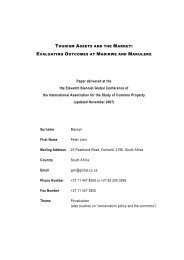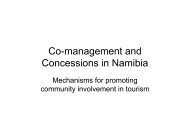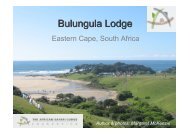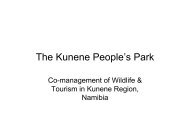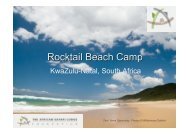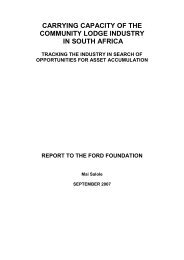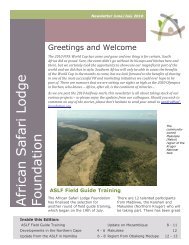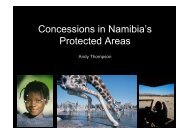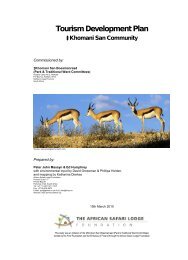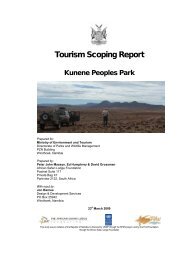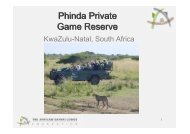socio-economic research on manda wilderness, lago district, niassa ...
socio-economic research on manda wilderness, lago district, niassa ...
socio-economic research on manda wilderness, lago district, niassa ...
You also want an ePaper? Increase the reach of your titles
YUMPU automatically turns print PDFs into web optimized ePapers that Google loves.
4.2 Impacts <strong>on</strong> Rural Livelihoods<br />
4.2.1 Sustainable Livelihoods Perspective<br />
A simplified livelihoods framework c<strong>on</strong>trasts with c<strong>on</strong>venti<strong>on</strong>al tourism perspectives which tend to focus<br />
exclusively <strong>on</strong> <str<strong>on</strong>g>ec<strong>on</strong>omic</str<strong>on</strong>g>, commercial or envir<strong>on</strong>mental impacts. It also c<strong>on</strong>trasts with narrow<br />
assessment of local benefits focusing <strong>on</strong> job creati<strong>on</strong> and cash income. Taking a livelihoods<br />
perspective helps identify the wide range of impacts – direct and indirect, positive and negative – that<br />
matter to local people. Recognising livelihood c<strong>on</strong>cerns is important to ensure planning by ASL and<br />
Manda Wilderness is resp<strong>on</strong>sive to local needs. Research into tourism impacts <strong>on</strong> rural livelihoods in<br />
Namibia (Ashley 2000) has dem<strong>on</strong>strated that:<br />
� The development impact of tourism is not uniform and it will vary within and between communities;<br />
� �Enhancing the livelihood impacts of tourism does not mean simply maximising the number of<br />
tourism developments or maximising wage income;<br />
� �A wide range of costs and benefits need to be taken into account. In particular, it is as important to<br />
address negative impacts (as to maximise positive <strong>on</strong>es) and address impacts <strong>on</strong> people’s assets<br />
and existing activities, not just direct c<strong>on</strong>tributi<strong>on</strong>s to household income and security;<br />
� �Careful planning and design, based <strong>on</strong> an understanding of local livelihoods, can greatly enhance<br />
the positive impacts of tourism;<br />
� Maximising livelihood benefits needs a good understanding of what people most need and want<br />
(their priorities) and the complex ways in which tourism impacts livelihoods directly and indirectly.<br />
Using this approach, the impacts of tourism can c<strong>on</strong>sidered in terms of effects <strong>on</strong> household assets,<br />
activities and strategies, household needs, the external policy envir<strong>on</strong>ment and people’s capacity to<br />
influence external forces.<br />
4.2.2 Impact <strong>on</strong> Assets<br />
Poverty assessments and participatory work with rural communities highlight the great importance of<br />
people’s assets and not just their income, in securing their livelihoods. This importance was reflected in<br />
villagers’ attitudes to the pilot lodge and proposed c<strong>on</strong>servati<strong>on</strong> area. The main impacts <strong>on</strong> five<br />
different types of capital are presented below (Table 9).<br />
Table 9 Impacts of <strong>on</strong> People’s Assets<br />
Negatives Positives<br />
Financial assets L<strong>on</strong>g term: possible equity in MWL<br />
Physical assets Tourism earnings invested<br />
e.g. small enterprises, ir<strong>on</strong> sheet roofs<br />
Human resources Training, skill development<br />
Natural resources Increased competiti<strong>on</strong><br />
Lost access to exclusive tourism and<br />
c<strong>on</strong>servati<strong>on</strong> areas<br />
C<strong>on</strong>flicts with neighbours<br />
Social capital Local c<strong>on</strong>flicts over tourism and<br />
c<strong>on</strong>servati<strong>on</strong><br />
Enhanced collective management<br />
Incentive to work together<br />
Str<strong>on</strong>ger social organisati<strong>on</strong><br />
Increased external links and influence<br />
The financial assets of local communities could be boosted in the l<strong>on</strong>ger term by purchase of equity in<br />
the lodge although discussi<strong>on</strong>s regarding this are in their infancy. Physical assets have been increased<br />
as several employees are investing their earnings in small enterprise development. For example, the<br />
tailor and boat operator at the lodge has built a shop and bar and two guest managers have invested in<br />
a backpackers in Mbueca village. It is likely that other staff also invest in house improvements.<br />
There are extremely limited opti<strong>on</strong>s for adult training in the Manda Wilderness area and it was<br />
surprising that the development of skills through the lodge was menti<strong>on</strong>ed <strong>on</strong>ly by a few interviewees.<br />
In order to use local labour, the lodge has had to invest in training. Most training is d<strong>on</strong>e by European<br />
volunteers. By training employees, MW hopes its staff will stay in the area. MW is also attempting to<br />
18



